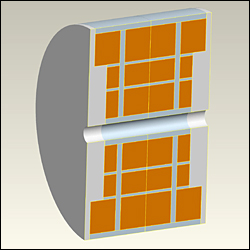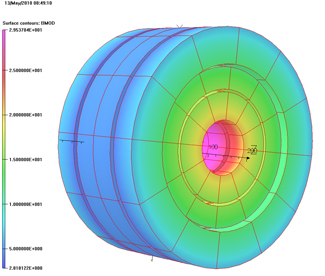Grant Funds Superconducting Magnet Energy Storage Research at Brookhaven Lab
UPTON, NY — The U.S. Department of Energy’s (DOE) Brookhaven National Laboratory and three collaborating institutions will receive a total of $4.2 million to develop a superconducting magnet energy
 |
| SMES coil blocks (brown) inside a mechanical structure (gray) picture from BNL |
Developing affordable, large-scale energy storage systems would be a game-changing advance for the U.S. electrical grid. In particular, energy storage will be crucial in enabling the widespread use of two key renewable energy sources: wind and solar power. Superconducting Magnet Energy Storage (SMES) systems use magnetic fields in superconducting coils to store energy with near-zero energy loss, and have instantaneous dynamic response and nearly infinite cycle life. ABB will lead the team in developing an SMES storage system for grid-scale energy storage.
"This exciting project is aimed at providing novel technologies for grid-scale energy storage solutions,” said Jim Misewich, Brookhaven’s Associate Laboratory Director for Basic Energy Sciences. “Such technologies are a key element in ensuring reliable operation of the 21st century electric grid and for the integration of renewable sources to reduce our carbon footprint."
Magnetic field (in Tesla) superimposed over one SMES coil unit made with the second generation High Temperature Superconductor (HTS)
Scientists at Brookhaven will lead the design and development of the SMES magnet and collaborate with SuperPower, Inc., a leading high-temperature superconducting (HTS) wire manufacturer, in the development of second-generation HTS wires. These wires are a key component of cost-effective grid-scale SMES systems that would offer megawatt hours of stored energy, supporting a growing renewable energy generation infrastructure, including wind
 |
|
Magnetic field (in Tesla) superimposed over one SMES coil unit made with the second generation High Temperature Superconductor (HTS)/picture from BNL |
“We are very excited to work with industrial leaders in developing the proposed cost-effective grid-scale SMES systems,” said Qiang Li, BNL team leader and head of the Advanced Energy Materials Group in the Condensed Matter Physics and Materials Science Department. “To achieve our goals, the performance of each of the individual subsystems that make up the proposed SMES system will have to be propelled far beyond the present state-of-the-art.
“SMES systems have come a long way since their inception in the 1970s,” he said. “Conventional SMES are usually used as short-term power devices designed to compensate for fluctuations in electrical power system. Making them into a grid-scale energy storage solution is a completely new ballgame.”
Magnetic field (in Tesla) superimposed over the SMES system consisting of several HTS coils
Li and his group proposed an ultra-high-field SMES-based storage solution that would bring down storage costs to a point where they would be comparable in cost per kilowatt-hour to conventional storage solutions. However, developing ultra-high-field SMES systems presents great technology challenges.
 |
|
Magnetic field (in Tesla) superimposed over the SMES system consisting of several HTS coils/picture from BNL |
‘We’re fortunate to have a unique combination of experience and facilities at Brookhaven in superconducting materials research and magnet development that gives us the necessary tools to take on these challenges,” said Li.
The multi-disciplinary team from Brookhaven includes scientists from the Magnet Division and from the Advanced Energy Materials group in the Condensed Matter Physics and Materials Science Department. With more than three decades of experience in building high-field magnets, the Brookhaven team will lead the design and development of the SMES magnet. In parallel, the team will work with the University of Houston to develop innovative approaches that significantly increase the performance of second-generation HTS wires while dramatically reducing their cost. The award was part of $92 million in grants announced last month by Energy Secretary Steven Chu for 43 research projects in 18 states. The grants aim to dramatically improve how the U.S. uses and produces energy by focusing on accelerating innovation in green technology while increasing America's competitiveness in grid scale energy storage, power electronics and building efficiency. The grants were the third and final round of grants totaling $349 million.